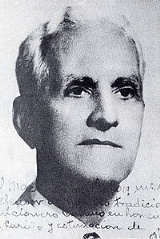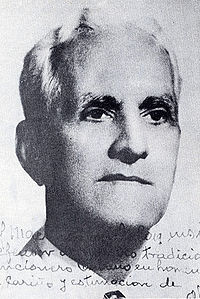
Alberto Villalón
Encyclopedia
Alberto Villalón Morales (Santiago de Cuba
, 7 June 1882 – Havana
, 16 July 1955) was one of the greatest musicians in the Cuban trova
style.
 He was the only one of the 'four greats' of the trova to come from a well-to-do family. Villalón and his sister América studied guitar with Pepe Sánchez, the father of the trova movement. Later, he studied classical guitar to achieve a really excellent technique. He composed his first canciones and boleros at fourteen, and moved to Havana in 1900. In 1907 he recorded on Edison cylinders. In 1908 he formed the Cuarteto Villalón with Adolfo Colombo
He was the only one of the 'four greats' of the trova to come from a well-to-do family. Villalón and his sister América studied guitar with Pepe Sánchez, the father of the trova movement. Later, he studied classical guitar to achieve a really excellent technique. He composed his first canciones and boleros at fourteen, and moved to Havana in 1900. In 1907 he recorded on Edison cylinders. In 1908 he formed the Cuarteto Villalón with Adolfo Colombo
(tenor), Claudio García (baritone), Emilio Reinoso (mandolin), and Alberto Villalón (guitar). Colombo and García were regular members of the Teatro Alhambra company; Colombo was the most recorded singer of the age.
A difference between Villalón and the other early trovadors was in his guitar technique. With his training he preferred picking (punteado) instead of strumming (rasgueado), which had been the main technique previously. This gave him a wider range of harmonic possibilities and a characteristic style. He had a second career in 1927 when he became a founding member of the Septeto Nacional
de Ignacio Piñeiro
. Alberto brought into the septet Juan de la Cruz and Benvenido León, who had been playing with him in a trio. The addition of the first really great sonero, Abelardo Barroso
(1905 – 1972), made the Nacional the best group in Cuba for its time.
Villalón's career, then, connected the world of trova with the world of son which became central to Cuba's popular music for the rest of the century.
Santiago de Cuba
Santiago de Cuba is the second largest city of Cuba and capital city of Santiago de Cuba Province in the south-eastern area of the island, some south-east of the Cuban capital of Havana....
, 7 June 1882 – Havana
Havana
Havana is the capital city, province, major port, and leading commercial centre of Cuba. The city proper has a population of 2.1 million inhabitants, and it spans a total of — making it the largest city in the Caribbean region, and the most populous...
, 16 July 1955) was one of the greatest musicians in the Cuban trova
Trova
Trova is one of the great roots of the Cuban music tree. In the 19th century a group of itinerant musicians known as trovadores moved around Oriente, especially Santiago de Cuba, earning their living by singing and playing the guitar...
style.

Adolfo Colombo
Adolfo Columbo was a leading singer in the Alhambra Theatre in Havana, and also an actor and a leading personality in the theatre...
(tenor), Claudio García (baritone), Emilio Reinoso (mandolin), and Alberto Villalón (guitar). Colombo and García were regular members of the Teatro Alhambra company; Colombo was the most recorded singer of the age.
A difference between Villalón and the other early trovadors was in his guitar technique. With his training he preferred picking (punteado) instead of strumming (rasgueado), which had been the main technique previously. This gave him a wider range of harmonic possibilities and a characteristic style. He had a second career in 1927 when he became a founding member of the Septeto Nacional
Septeto Nacional
Septeto Nacional , or the Septeto Nacional de Ignacio Piñeiro, is a group credited with expanding the Son musical style before Arsenio Rodríguez. It added the trumpet to percussion, vocals, and strings. The group started as a sextet in 1927 in Central Havana...
de Ignacio Piñeiro
Ignacio Piñeiro
Ignacio Piñeiro Martínez was a black Cuban musician and composer whose career started in rumba, and flowered in the rise of the son. He was one of the most important composers of son music; in total he wrote about 327 numbers, mostly sones.Piñeiro was a brilliant rumbero who worked with musical...
. Alberto brought into the septet Juan de la Cruz and Benvenido León, who had been playing with him in a trio. The addition of the first really great sonero, Abelardo Barroso
Abelardo Barroso
The singer Abelardo Barroso Dargeles was the first sonero mayor to be recognized as such by the Cuban public. He was the lead singer of the Sexteto Habanero from 1925, recorded with the Sexteto Boloña in 1926, and joined the Septeto Nacional de Ignacio Piñeiro in 1927...
(1905 – 1972), made the Nacional the best group in Cuba for its time.
Villalón's career, then, connected the world of trova with the world of son which became central to Cuba's popular music for the rest of the century.
External links
- Discography of Alberto Villalón on Victor RecordsVictor Talking Machine CompanyThe Victor Talking Machine Company was an American corporation, the leading American producer of phonographs and phonograph records and one of the leading phonograph companies in the world at the time. It was headquartered in Camden, New Jersey....
from the Encyclopedic Discography of Victor Recordings (EDVR)

